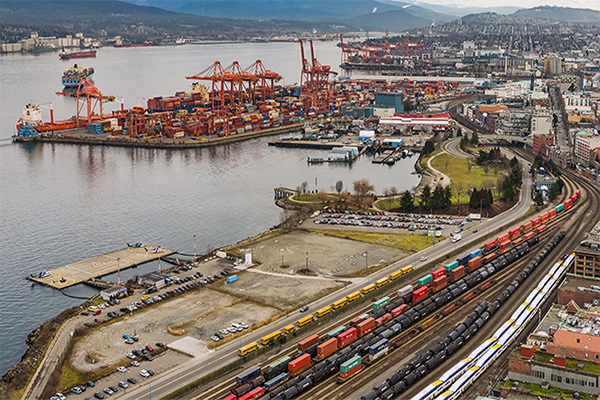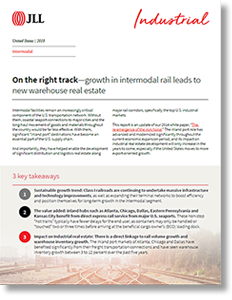Intermodal Growth Starting to Pay Off with Inland Ports’ Development

According to new JLL research, a looming capacity shortage in the trucking industry, coupled with rail’s high efficiency, is causing logistics suppliers and transportation providers to turn their focus to intermodal for their supply chain solutions.
Intermodal Usage
As the United States intermodal volumes have been ahead of carload volumes in recent years, a report recently published by Chicago-based commercial real estate firm JLL explains that should this continue to remain that case.
Increased intermodal usage will not only see supply chains drive more cargo off of highways and onto rail, but it will also serve as a driver to increase real estate development in close proximity to inland ports.
A key thesis of the report, entitled “On the right track, growth in intermodal rail leads to new warehouse real estate,” explained that this type of real estate development is expected to see growth, should the U.S. shift to more export-oriented growth.
The reason for this, JLL explained, is the direct linkage between rail volume growth and warehouse inventory growth.
Using the inland port markets in heavy freight regions Atlanta, Chicago, and Dallas, it said that each has seen significant benefits from freight transportation connections, with warehouse inventory growth ranging from 3%-12% over the last five years.
JLL noted that intermodal facilities, and, by extension, inland ports, are an increasingly critical component of the U.S. transportation network, as coastal seaport connections to major cities and the long-haul movement of goods materials throughout the U.S. would be much less effective.
And it added that significant inland port destinations have become an essential part of the U.S. supply chain, as well as helped to enable the development of significant distribution and logistics real estate along major rail corridors, with a key focus in the top U.S. industrial markets.
“The inland port role has advanced and modernized significantly throughout the current economic expansion period, and its impact on industrial real estate development will only increase in the years to come, especially if the United States moves to more export-oriented growth,” the report stated.
Continued Intermodal Growth
Drivers for continued intermodal growth that can lead to increased inland port development cited in the report include: Class I railroads continuing to undertake massive infrastructure and technology improvements; major inland hubs benefitting from direct express rail service from major U.S. seaports; and the aforementioned direct linkage to rail volume growth and warehouse inventory growth.
Chad Buch, JLL Research Manager, explained in an interview that this JLL paper served as a “refresh” of a 2014 intermodal publication, entitled “The re-emergence of the iron horse.”
“This is really an expansion of some of the trends we looked at then,” Buch said.
“The sector has continued to grow tremendously and had a big impact on industrial warehousing and real estate, coupled with a big picture look at the supply chain like the Panama Canal, the driver shortage, and labor shortages. It is perfect timing with a combination of those factors and market growth and how intermodal intersects with the warehouse market.”
Given the solid volumes intermodal is seeing, JLL thinks there is a fair amount of room, on highways and trucking, for it to run into the future.
George Cutro, JLL Director of Industrial Research, said the current level of intermodal emergence is akin to the adolescent stage and is being driven by trucking and rail working more in tandem to deliver goods to the end user, or consumer.
“Ten years ago, a person would look through a catalog, order something, and it would arrive in a week’s time, now, that turnaround is down to two days or just a few hours, and with the driver shortage and a massive amount of goods moving more rapidly, the intermodal segment is more comfortable moving goods from point A to point B and able to leverage it for shorter runs to inland ports, too, to get goods to consumers.”
Trucking Lacking Significant Capacity
Walter Kemmsies, Managing Director, Economist and Chief Strategist of JLL’s Port, Airport and Global Infrastructure (PAGI) Group, explained that one reason that this segment is gaining traction now, as opposed to different periods in the past is that, the trucking sector lacks significant extra capacity, and when the sector felt it was losing a bit of market share, rates could be aggressively lowered in certain markets, like in New York, and, in turn, bankrupted the effort to shift away from trucks.
“There is not that kind of spare capacity today,” Kemmsies said.
Read: Walter Kemmsies Talks Economics, Supply Chain, NAFTA before Jump Start 2019 Conference
“Truckers are saying that warehouses, which stay open 24 hours a day, could get more usage if there were more drivers putting in those hours. They are coming up with ways to change the nature of logistics, just so they can acquire some more truck capacity. It is a clear indication it is just not there. The trucking sector does not have the same capacity to fight back and maintain market share that it did in the past. The trends and structure [for inland intermodal ports] are there. The timing is there because the trucking sector currently lacks the capacity to react.”
Looking at the current state of development for inland ports, JLL’s Buch said that, in terms of big box space, there is a bit of oversupply when compared with tenant demand, in some key markets, like Denver and Salt Lake City, for example.
“Those are big box markets, where intermodal is definitely a factor, and there is definitely a connection between intermodal traffic in those markets and growth and supply,” he said.
Related Article: “Intermodal Gives Shippers, 3PLs Relief from Tight Trucking Market” Jeff Heller, Norfolk Southern
Intermodal White Papers & Guides
Growth in Intermodal Rail Leads to New Warehouse Real Estate
Trucking is by far the predominant mode of shipping in the U.S., but it has its constraints, from driver shortages to escalating costs and roadway congestion, and while freight matching technology is improving, it also has helped the intermodal industry move into its next evolution as well. Download Now!
Supply Chain Trends
A pool of over 150 supply chain professionals was asked about their transportation plans, challenges and opportunities for growth, the results provide insight into a wide range of issues and shed light on what supply chain managers plan to focus on in the coming year. Download Now!
The X’s and O’s of Intermodal Rail in Supply Chain Management
As the coach of your supply chain, you have the opportunity to turn to your playbook and choose from multiple transportation modes to maximize the efficiency of your freight network. Download Now!
The Intermodal Rail Bracketology Guide
Learn how to identify sub-optimal full-truckload freight that is vulnerable to capacity constraints if and when a supply chain disruption occurs. Download Now!
Practical Steps for Highway to Intermodal Rail
Learn how to increase access to capacity, reduce transportation costs and mitigate exposure to future trucking regulations. Download Now!
Transportation Management Systems & Intermodal Rail
An interactive, personalized guide to learn more about the combined benefits of a TMS and intermodal rail. Download Now!
Highway to Intermodal Rail (H2R) Conversions Deliver Bottom Line Results
CSX Transportation has found that 96% of shippers have sub-optimized freight in their network. Does your organization? Find out and learn how to address sub-optimized freight in your supply chain. Download Now!
More: Intermodal Resources
Article Topics
CSX News & Resources
Signs of progress are being made towards moving cargo in and out of Baltimore Top CSX executive places a sharp emphasis on railroading as a career path and service at NEARS Intermodal innovation? Crisis averted on U.S. railroads, with carriers and unions reaching tentative agreements CSX’s acquisition of Pan Am Railways is a done deal Baltimore breaks ground for double-stacking 126-year-old tunnel in ‘absolute game-changer’ CSX executive discusses railroad trends and themes at NEARS conference More CSXLatest in Transportation
Why are Diesel Prices Climbing Back Over $4 a Gallon? Luxury Car Brands in Limbo After Chinese Company Violates Labor Laws The Three Biggest Challenges Facing Shippers and Carriers in 2024 Supply Chain Stability Index: “Tremendous Improvement” in 2023 Trucking Association CEO on New Biden Policy: ‘Entirely Unachievable’ Two Weeks After Baltimore, Another Cargo Ship Loses Power By Bridge Examining the freight railroad and intermodal markets with Tony Hatch More TransportationAbout the Author






















